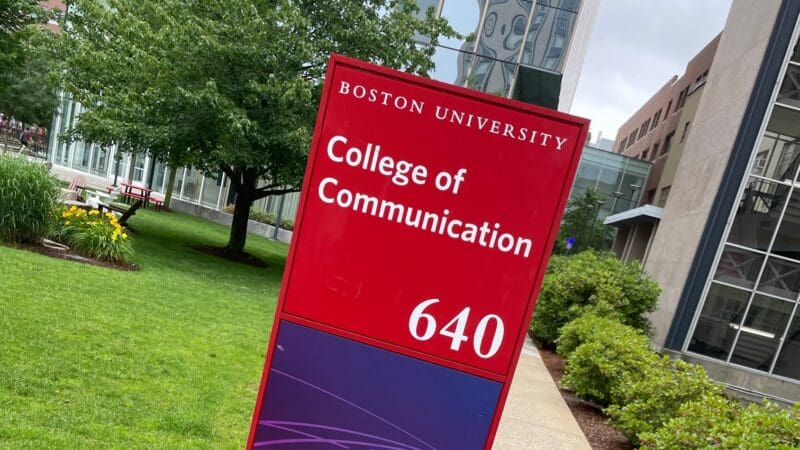A healthy democracy needs a robust and active culture of journalism, and at the heart of journalism in a democracy is the act of questioning: journalists asking questions that help inform readers and hold decision makers and public officials accountable.
For journalists, questioning is a powerful tool, an art and a science, something that requires foresight, strategic thinking, and adaptation.
That’s why the Right Question Institute was pleased to work recently with the upcoming generation of journalists through Boston University’s Summer Journalism Academy.
This summer program attracts high school students from around the world who are interested in journalism and take the opportunity to learn at one of the United States’ leading journalism schools.
Questions and interviewing
As part of a day focused on the topic of interviewing, RQI worked with about 55 student-journalists to introduce them to the Question Formulation Technique (QFT) — a structured method they can use to generate questions, improve them, and strategize on how to use them.
They also learned about emerging ideas for how newsrooms can use the QFT to engage communities and strengthen the critical relationship that holds journalism, people, and democracy together.
The session was part of a class organized by Rochelle Sharpe, a Pulitzer-prize winning journalist who teaches at Boston University.
Amanda Becker, who recently completed a Nieman Fellowship at Harvard, facilitated the QFT session for students. As a journalist, she covers happenings in Washington D.C. for The 19th, a nonprofit news organization reporting on gender, politics, and policy. She’s also worked for Reuters and has appeared in The Washington Post, National Public Radio, The New Republic, and other news outlets.
Becker learned about the QFT at Harvard through a course at the Graduate School of Education called Building Nimble and Democratic Minds: From Practice to Theory and Back to Practice. This course was developed and taught by Luz Santana and Dan Rothstein, RQI’s co-founders and co-directors of democracy-building programs.
A way for journalists to generate, improve, and plan questions
As part of the session, Becker used a slightly altered local newspaper headline as a Question Focus, a catalyst for generating questions: “Amazon is launching delivery networks using local businesses and Boston is a test market.”
Learn more about the QFT and its different components
Working in groups, the high-school journalists formulated lists of questions they might use to interview key individuals in order to write a (hypothetical) news story about the topic.
As Becker noted, this activity is similar to what journalists at wire services do when tidbits of incomplete information come into the newsroom and reporters scramble to pursue and produce a story.
After generating questions, students discussed the benefits and drawbacks of closed-ended and open-ended questions, thinking about the strategic importance of each in a journalistic setting, especially when interviewing high-profile officials or decision-makers. Then, they improved and prioritized questions they might ask in order to write the Amazon delivery network story.
Offering practical advice about questions
After facilitating the QFT, Becker shared some practical question-oriented advice for working as a journalist. For instance, “I think of closed-ended questions as accountability questions,” she said. And she noted that when you’re interviewing someone in power — a CEO, a politician — “you’re not going to get much time.” You need to walk into the interview with a list of priority questions, and you need to be nimble as the interview moves forward, prioritizing and strategizing about your questions as you go along.
Another piece of advice, prompted by a student who was curious about what order to ask questions in: In general, start interviews with a medium-important question so you don’t frighten the interviewee. Ask the question where they walk out of the room last.
Here are some other things students asked about journalism and questions:
- How do you balance the questions you want to have answered with the ones you need to have answered?
- In a breaking news situation, do you ask closed- or open-ended questions?
- How do you decide what angle to take on a story?
Using the QFT to strengthen newsroom-community relationships
Using the QFT “gives you a better idea of your own story,” Becker said. She also spoke about how the QFT could be used in new ways to foster better engagement between communities and newsrooms — strengthening a relationship that is key to a healthy democracy but that seems to have broken down in recent years.
As news outlets struggle to survive, more people are turning to social media and elsewhere for news — spaces often containing misinformation, disinformation, conspiracy theories, and polarized ways of thinking.
“We have a major crisis right now in journalism in that people don’t trust the news anymore,” Becker said. She added, “Clearly, as an industry we are not giving people what they want.”
As a member of a nonprofit newsroom, she sees the QFT as a way journalists could engage with readers and have communities name for themselves the questions that concern them and that they want answered. For instance, she said journalists could use the QFT to talk to people ahead of an important public meeting to understand what the community wants to know.
“Democracy cannot really thrive without journalism,” she said, and the QFT is one way journalists can work with people “in a mode of democratic thinking.”
